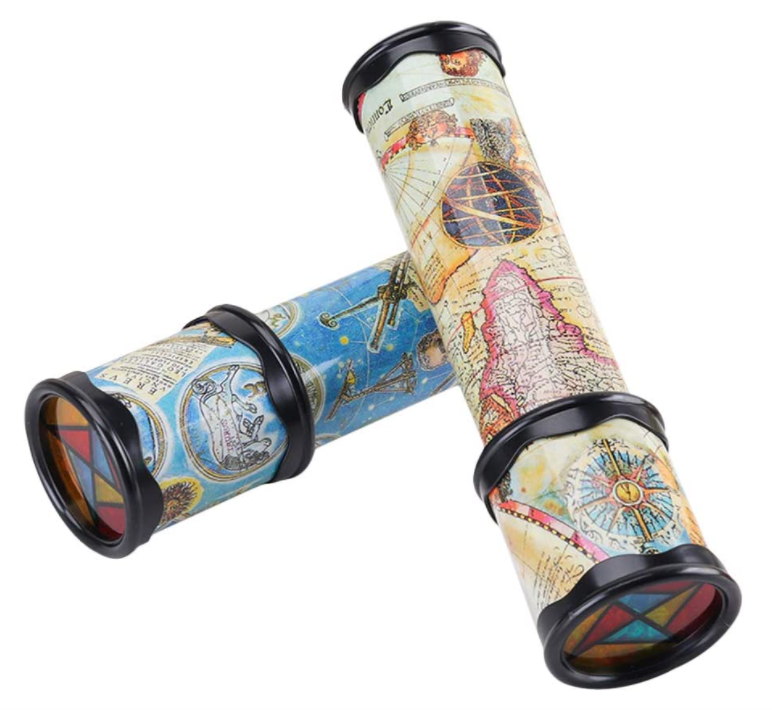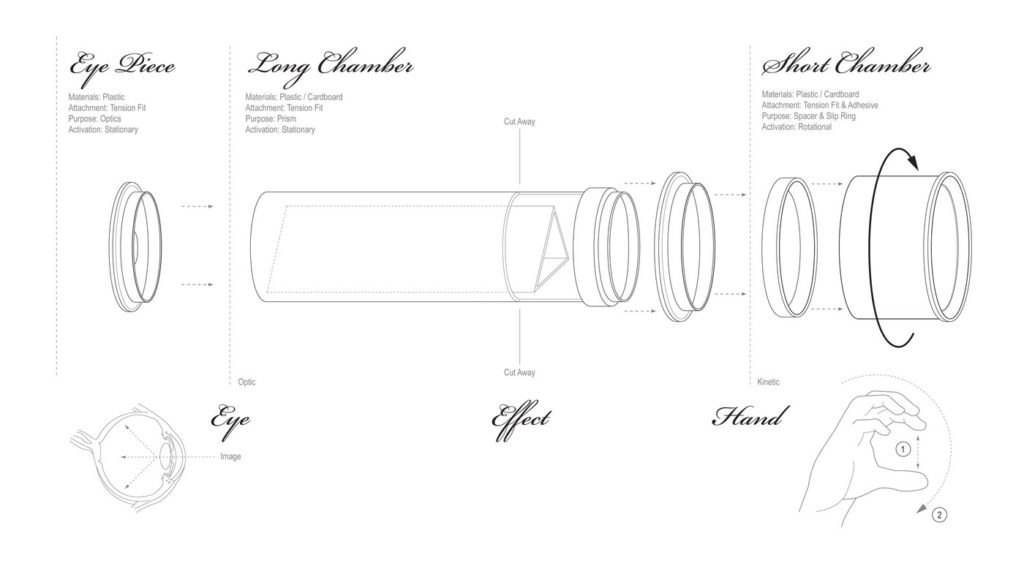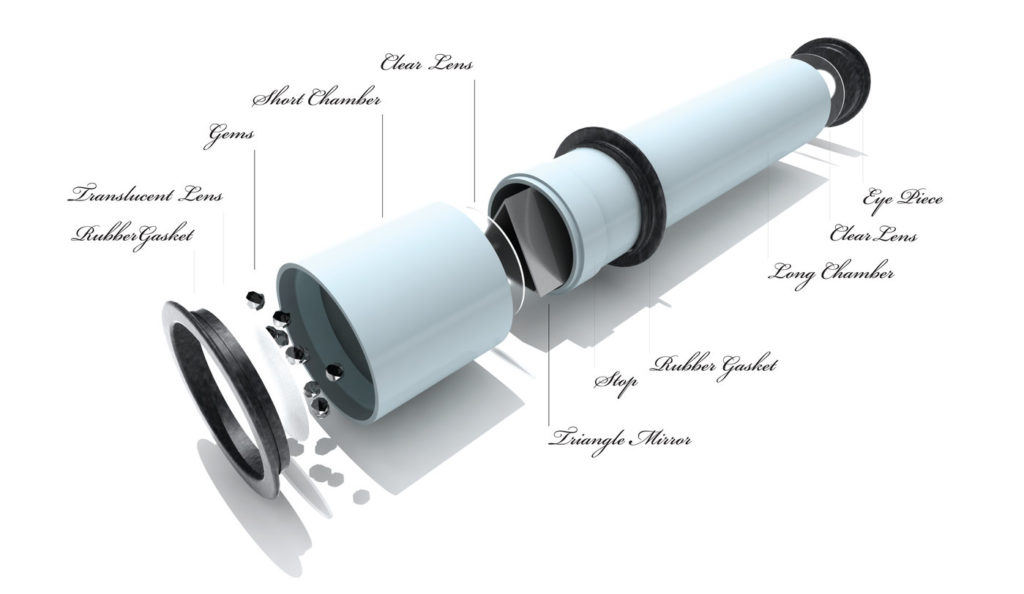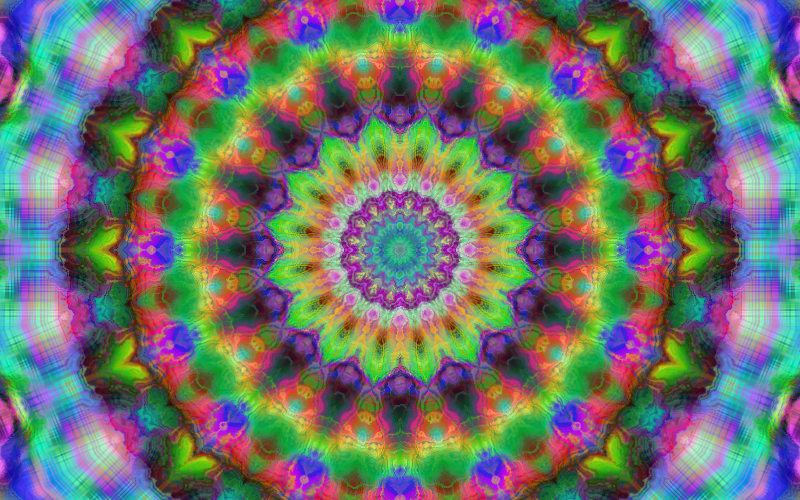
Kaleidoscope
A kaleidoscope is an optical equipment containing two or more reflecting surfaces (or mirrors) inclined at an angle to one another, so that when viewed from the other end, one or more (parts of) objects appear as a regular symmetrical pattern. These reflectors are typically housed in a tube, with a small chamber on one end containing loose, coloured glass or other transparent (and/or opaque) materials to be reflected into the seen pattern. The materials move in response to the rotation of the small chamber, giving in a constantly changing view.
Components:
- Cilindrical tube
- Internal mirrors (e.g. 3 mirrors forming a triangular prism)
- Small chamber with objects (rotating)
Working Principle:
A simple kaleidoscope is made up of two thin wedge-shaped mirror strips that touch along a shared edge, or a single sheet of shiny aluminium twisted at a 60° or 45° angle. The mirrors are contained within a tube that has a viewing eyehole on one end. A small chamber (that can be rotated) is at the other end; it is made of two glass discs, the outer one ground to act as a diffusing screen. Colored glass, tinsel, and beads can be found in this chamber. The objects inside the chamber tumble into an arbitrary grouping when the chamberis twisted or tapped, and when the diffusing screen is lighted, the sixfold or eightfold multiplication creates a remarkable symmetrical pattern. The number of possible combinations and patterns is infinite.

Cilindrical tube
A reflecting substance is the first and most important aspect of the kaleidoscope.
Mirrors are used in the majority of kaleidoscopes.
Long, thin mirrors are arranged so that they face each other.
Depending on the end design sought, different numbers of mirrors can be employed, but three mirrors are typically used to form a pattern based on repeating triangles.
Kaleidoscopes are commonly made of cardboard, but they can be made of any round, hollow material.
A paper roll with aluminium foil for a reflecting surface can be used to make homemade kaleidoscopes.
Tin was used to make older kaleidoscopes.
In certain variations, three triangle-shaped pieces of blown glass are used.

Small chamber with objects
The objects to be reflected are kept in the object chamber at one end of the kaleidoscope. Beads, string, and paper clips can be used to make a handmade kaleidoscope. A traditional kaleidoscope is made up of coloured plastic or glass pieces. The kaleidoscope’s end is sealed with glass or plastic. This not only keeps the objects contained, but it also allows light to pass through, allowing the images to be reflected. The kaleidoscope’s end spins in certain models, allowing for the creation of a variety of designs. For the same effect, homemade copies can be rotated by hand. Glass marbles with different patterns and shapes can be used for different models.
Viewing hole
The kaleidoscope’s other end is used for viewing. It can also be closed off as long as there is a little viewing hole. The hole is brought up to the eye so that the person may view the patterns generated by the reflections by looking down through the mirrors.
Light and movement
When staring through the hole, light filters through the glass (or clear plastic) on the object chamber’s end, illuminating the objects, which then reflect off all of the mirrors. As the light goes through the tube, the reflections bounce off one another. The patterns are created by the eye seeing these bouncing reflections. The objects in the chamber shift as the kaleidoscope revolves, and the reflection changes, creating new patterns. The principle is straightforward, yet the ultimate effect is delightful and entertaining.

Instructions:
- Point the kaleidoscope to a light source or a bright surface (e.g. blue sky)
- Look through the viewing hole
- Rotate the object chamber to see an amazing pattern changing
Links:
https://www.britannica.com/facts/kaleidoscope
https://en.wikipedia.org/wiki/Kaleidoscope
https://sciencing.com/a-kaleidoscope-work-4564059.html
https://science.howstuffworks.com/kaleidoscope.htm
https://www.coroflot.com/cham0152/graduate-studio-third-year